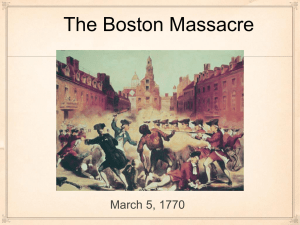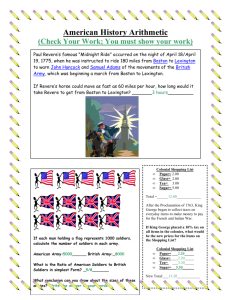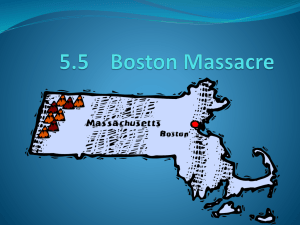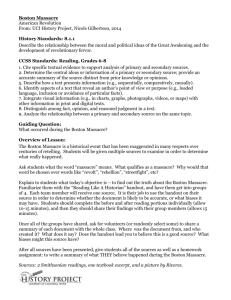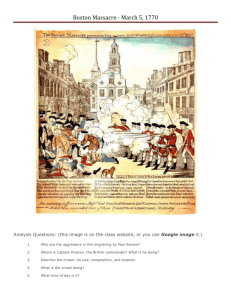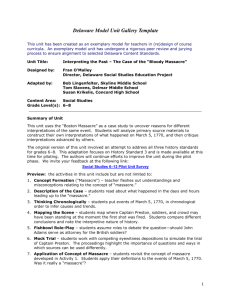Multiple Perspectives: Primary Source Activity
advertisement
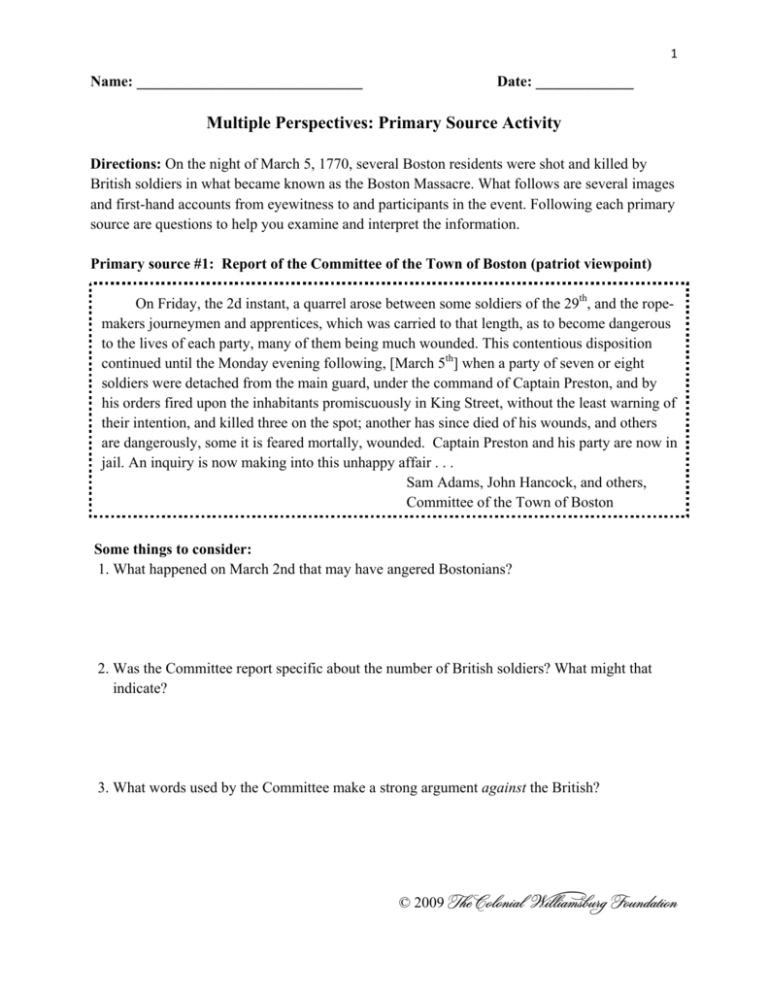
1 Name: ______________________________ Date: _____________ Multiple Perspectives: Primary Source Activity Directions: On the night of March 5, 1770, several Boston residents were shot and killed by British soldiers in what became known as the Boston Massacre. What follows are several images and first-hand accounts from eyewitness to and participants in the event. Following each primary source are questions to help you examine and interpret the information. Primary source #1: Report of the Committee of the Town of Boston (patriot viewpoint) On Friday, the 2d instant, a quarrel arose between some soldiers of the 29th, and the ropemakers journeymen and apprentices, which was carried to that length, as to become dangerous to the lives of each party, many of them being much wounded. This contentious disposition continued until the Monday evening following, [March 5th] when a party of seven or eight soldiers were detached from the main guard, under the command of Captain Preston, and by his orders fired upon the inhabitants promiscuously in King Street, without the least warning of their intention, and killed three on the spot; another has since died of his wounds, and others are dangerously, some it is feared mortally, wounded. Captain Preston and his party are now in jail. An inquiry is now making into this unhappy affair . . . Sam Adams, John Hancock, and others, Committee of the Town of Boston Some things to consider: 1. What happened on March 2nd that may have angered Bostonians? 2. Was the Committee report specific about the number of British soldiers? What might that indicate? 3. What words used by the Committee make a strong argument against the British? © 2009 †he çolonial  ƒoundation 2 Primary source #2: Testimony from Bostonian William Tant (providing a view much less one-sided view than the Committee’s) . . . I saw a party of soldiers come from the main guard, and draw themselves up in a line from the corner of the Customs-house to the sentry-box; the people still continued in the street, crying “Fire, fire, and be damned,” and hove [throw] some more snow balls; whereupon I heard a musket go off, and in the space of two or three seconds, I heard the word “Fire” given, but by whom I do not know, and instantly the soldiers fired one after another. I then stood between the sentry-box and the Custom-house door. And further I know not. Some other considerations: 1. Who gave the order to fire? Was it Captain Preston or someone in the patriot crowd? 2. What did the crowd do that may have frightened the soldiers into thinking they might be attacked by the people in the street? 3. What more could Mr. Tant describe after the shots were fired? © 2009 †he çolonial  ƒoundation 3 Primary source #3: Testimony from [British] Captain Thomas Preston (provides an entirely different perspective on the events of March 5, 1770) About 9, some of the guard came to and informed me the town inhabitants were assembling to attack the troops, that that the bells were ringing as the signal for that purpose . . . In my way there, I saw people in great commotion, and heard them use the most cruel and horrid threats against the troops . . . about 100 people passed . . . towards the custom house where the king’s money is lodged. They immediately surrounded the sentry [British soldier] posted there, and with clubs and other weapons threatened to execute their vengeance on him. I was soon informed by a townsman their intention was to carry off the soldier from his post and probably murder him . . . he assured me he heard the mob declare they would murder him. This I feared might be a prelude to their plundering [stealing] the king’s chest. I immediately sent an officer and 12 men to protect the sentry and the king’s money . . . they [the soldiers] rushed through the people and by charging their bayonets in half circles, kept them [the townspeople] at a little distance . . . the unhappy affair took place without any loading in their pieces [muskets]; nor did I ever give orders for loading them. The mob still increased and were more outrageous, striking their clubs…and calling out, come on you rascals, you bloody backs, you lobster scoundrels, fire if you dare . . . fire . . . At this time I was between the soldiers and the mob, parleying with and endeavoring all in my power to persuade them to retire peacefully, but to no purpose. Is this a different perspective? Let’s see . . . 1. At 9:00 at night, why were the bells ringing in Boston? Was it some sort of signal? 2. The event took place near a customs house. Why might this be important information to consider? 3. From Captain Preston’s point of view, what was the intent of this unruly crowd? 4. How did Captain Preston attempt to settle this matter? © 2009 †he çolonial  ƒoundation 4 Primary source #4: Continuing with Captain Preston’s recollection of this event (provides an entirely different perspective on the events of March 5, 1770) They [the mob] advanced to the points of the bayonets, struck some of them and even the muzzles [the front of the muskets] of the pieces, and seemed to be endeavoring to close with the soldiers . . . some well behaved persons asked me if the guns were charged [loaded] and I replied yes . . . they then asked if I intended to order the men to fire. I answered no, by no means, observing to them that I was advanced before the muzzles of the men’s pieces [he was standing in front of their guns] and must fall a sacrifice if they fired; and my giving the word fire under those circumstances would prove me to be no officer. While I was thus speaking, one of the soldiers have received a severe blow with a stick, stepped a little on one side and instantly fired, on which turning and asking why he fired without orders, I was struck with a club on my arm, which for some time deprived me of the use of it, which blow had it been placed on my head, most probably would have destroyed me. On this a general attack was made on the men [Redcoats] by a great number of heavy clubs and snowballs being thrown . . . by which all our lives were in imminent [immediate] danger . . . Instantly three or four soldiers fired, one after another, and directly after three more in the same confusion and hurry. The mob ran away, except three unhappy men who instantly expired . . . On my asking the soldiers why they fired without orders, they said they heard the word fire and supposed it came from me. This might be the case as many of the mob called out fire, fire, but I assured the men that I gave no such order. Is this yet another perspective? 1. Was the mob becoming more intense and dangerous? What makes you think this way? 2. Which side seems to be at blame for starting the firing of muskets? What evidence from Preston’s testimony made you think this was so? 3. Would Captain Preston have any reason to tell less than the exact truth? Give a reason for your answer. © 2009 †he çolonial  ƒoundation 5 Primary Source #5: Paul Revere’s Engraving “The Bloody Massacre Perpetrated in King-Street . . .” “The Bloody Massacre Perpetrated in King Street on March 5th, 1770 . . . ,” engraved by Paul Revere, Boston, Massachusetts, 1770. From the collections of the Colonial Williamsburg Foundation. © 2009 †he çolonial  ƒoundation 6 Paul Revere Engraving—“The Bloody Massacre Perpetrated in King-Street . . .” Some things to consider . . . 1. Based on this engraving, who looks like the victims, the British soldiers or the American colonists? Explain. 2. How would you describe the behavior and actions of the crowd? 3. How would you describe the behavior and actions of the British soldiers? 4. Paul Revere, an American, made this engraving. Why is this important information when interpreting this piece of art? © 2009 †he çolonial  ƒoundation 7 Primary Source #6: Paul Revere’s Newspaper Engraving of Four Coffins of Men Killed in the Boston Massacre Detail from newspaper showing four coffins of men killed in the Boston Massacre, The Boston Gazette, and Country Journal, March 12, 1770. Courtesy of the Library of Congress, Newspapers and Current Periodicals Reading Room. © 2009 †he çolonial  ƒoundation 8 Paul Revere Newspaper Engraving of Four Coffins of Men Killed in the Boston Massacre Some things to consider . . . 1. In the text above the coffins, how are the four dead men described? What does this text tell you about the author’s opinion of the Boston Massacre? 2. How did Paul Revere try to make readers feel when they looked at the coffins? What evidence do you have to support your opinions? 3. When Revere created his art, was he considering multiple opinions? Explain your answer and offer evidence. © 2009 †he çolonial  ƒoundation 9 The Trial: During the fall of 1770, trials were held for the thirteen men indicted for the murder of Boston civilians on that night, March 5, 1770. Some historians consider this the most important trial of the eighteenth century. Who better to handle the defense of these men than John Adams, a patriot and a man of absolute character! His task was most difficult . . . to defend the soldiers he had to allow testimony proving the terrible behavior of the Boston mob. If the soldiers were found guilty, they would be hanged and the relations between Great Britain and America would explode. The Outcome: Captain Preston was acquitted, as were most of the soldiers. Two soldiers, however, were found guilty of manslaughter. They were burned on the left thumb and discharged. Primary Source #7: An excerpt from Diary and Autobiography of John Adams I have Reason to remember that fatal Night. The Part I took in Defense of Captn. Preston and the Soldiers, procured me Anxiety, and Obloquy enough. It was, however, one of the most gallant, generous, manly and disinterested Actions of my whole Life, and one of the best Pieces of Service I ever rendered my Country. Judgment of Death against those Soldiers would have been as foul a Stain upon this Country as the Executions of the Quakers or Witches, anciently. As the Evidence was, the Verdict of the Jury was exactly right. This however, is no Reason why the Town should not call the Action of that Night a Massacre, nor is it any Argument in favour of the Governor or Minister, who caused them to be sent here. But it is the strongest Proofs of the Danger of Standing Armies. Here we have a difficult, but very important, primary source . . . 1. Is John Adams proud of his role as defense attorney for Captain Preston and the other British soldiers? What words or sentences from this quotation support that? 2. John Adams still believed that the term “massacre” was appropriate. Even though he was the defense attorney, what is his reason for making such a statement? © 2009 †he çolonial  ƒoundation


